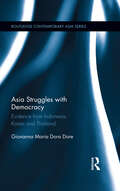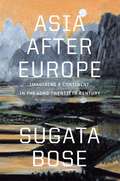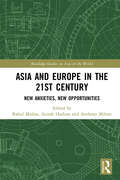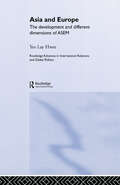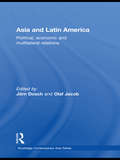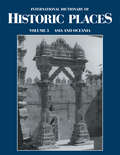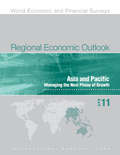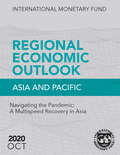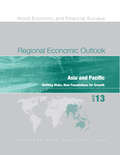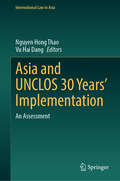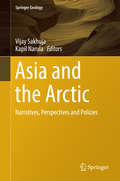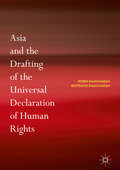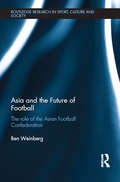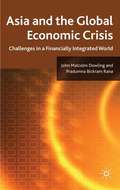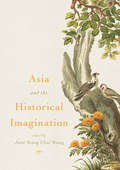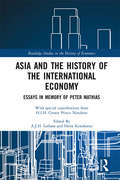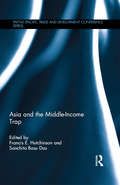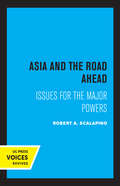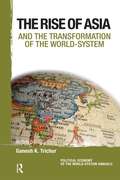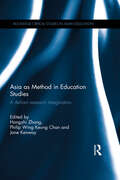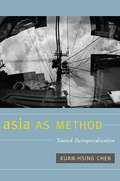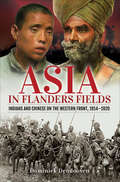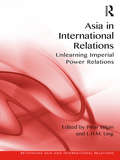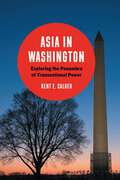- Table View
- List View
Asia Rising: A Sectoral Perspective
by Florence Jaumotte Nikola SpataforaA report from the International Monetary Fund.
Asia Struggles with Democracy: Evidence from Indonesia, Korea and Thailand (Routledge Contemporary Asia Series)
by Giovanna Maria DoreSince 1974, when the current wave of democratisation began, the movement towards democracy in Asia has remained limited. Many countries in Asia, in fact, are not making a decisive move towards democracy, and find themselves struggling with the challenges of democratic consolidation and governance. Focusing on Indonesia, Thailand and Korea, this book analyses why democratisation is so difficult in Asia. The book investigates the dynamics by which citizens embrace democratic rule and reject authoritarianism, and also compares these dynamics with those of consolidating democracies around the world. The book looks at the forces that affect the emergence and stability of democracy, such as elite interactions, economic development and popular attitudes as beliefs and perceptions about the legitimacy of political systems have long been recognised as some of the most critical influences on regime change. The book also discusses what it is about the nature of public opinion and the processes of day-to-day democratic participation that have made these countries vulnerable to repeated crises of legitimacy. Using Indonesia, Korea, and Thailand as case studies, this book highlights the uniqueness of the Asia’s path to democracy, and shows both the challenges and opportunities in getting there. The book will be of interest to students and scholars of Asian Politics, Comparative Politics and International Studies.
Asia after Europe: Imagining a Continent in the Long Twentieth Century
by Sugata BoseA concise new history of a century of struggles to define Asian identity and express alternatives to European forms of universalism.The balance of global power changed profoundly over the course of the twentieth century, above all with the economic and political rise of Asia. Asia after Europe is a bold new interpretation of the period, focusing on the conflicting and overlapping ways in which Asians have conceived their bonds and their roles in the world. Tracking the circulation of ideas and people across colonial and national borders, Sugata Bose explores developments in Asian thought, art, and politics that defied Euro-American models and defined Asianness as a locus of solidarity for all humanity.Impressive in scale, yet driven by the stories of fascinating and influential individuals, Asia after Europe examines early intimations of Asian solidarity and universalism preceding Japan’s victory over Russia in 1905; the revolutionary collaborations of the First World War and its aftermath, when Asian universalism took shape alongside Wilsonian internationalism and Bolshevism; the impact of the Great Depression and Second World War on the idea of Asia; and the persistence of forms of Asian universalism in the postwar period, despite the consolidation of postcolonial nation-states on a European model.Diverse Asian universalisms were forged and fractured through phases of poverty and prosperity, among elites and common people, throughout the span of the twentieth century. Noting the endurance of nationalist rivalries, often tied to religious exclusion and violence, Bose concludes with reflections on the continuing potential of political thought beyond European definitions of reason, nation, and identity.
Asia and Europe in the 21st Century: New Anxieties, New Opportunities (Routledge Studies on Asia in the World)
by Rahul MishraHow are the rising mutual concerns of Asian and European countries shaping their approaches to the international order? Contributors to this volume discuss emerging critical issues in International relations, including the Indo-Pacific constructs, China’s Belt and Road Initiative (BRI), and the progress of established regional security mechanisms like the Shanghai Cooperation Organisation. They also compare western and non-western approaches to these issues, with a holistic perspective on the origins and evolutions of these approaches. Both the Indo-Pacific constructs and BRI present a remarkable set of opportunities for Europe as well as Asia. This book presents key implications of the changing politico-security dynamics in the two regions from the perspectives of both Asian and European scholars and theoretical traditions. A must-read for scholars of International Relations with a focus on relations between Asia and Europe.
Asia and Europe: The Development and Different Dimensions of ASEM (Routledge Advances in International Relations and Global Politics)
by Lay Hwee YeoThis book provides a systematic and thorough examination of the Asia-Europe Meeting (ASEM) process which brings together the fifteen EU member states, the European Commission and ten East and Southeast Asian countries. The author not only traces the actual development of the ASEM process, but also contextualises ASEM within three different international relations theoretical frameworks, as viewed by realists, social constructivists and institutionalists.
Asia and Latin America: Political, Economic and Multilateral Relations (Routledge Contemporary Asia Series)
by Jörn DoschUntil the late 1980s, Japan was the only country in Asia with notable political and economic relations. Since then, however, several Asian nations have perceived growing links with the Latin American region as a means of diversifying their political and particularly economic relations while many Latin American decision-makers have increasingly recognised the strategic importance of East Asia in their foreign policy and foreign economic policy designs. This book analyses the economic, political and socio-cultural relations between Asia and Latin America and examines their growing importance in international relations. In the first part of the book the contributors look at the policies, interests and strategies of individual Asian and Latin American states, while the second part delves into the analysis of multilateral institution-building in Asia-Latin America relations,. As such, Asia and Latin America will be of interest to undergraduate and postgraduate scholars of comparative politics, international relations, Asian politics and Latin American politics.
Asia and Oceania: International Dictionary of Historic Places
by Christopher Hudson Trudy Ring Sharon La Boda Robert M. Salkin K. A. Berney Paul E. SchellingerFrom the Taj Mahal to the Parthenon, from Gettysburg to Heidelberg, from Beacon Hill to Tower Hill, from the Great Wall to Hadrian's Wall, from Jerusalem to Kyoto, the International Dictionary of Historic Places presents some 1,000 comprehensive and fully illustrated histories of the most famous sites in the world. Entries include: location, description, and site office details; and a 3,000 to 4,000 word essay that provides a full history of the site and the condition of the site today. An annotated Further Reading list of books and articles about the site completes each entry.
Asia and Pacific Managing the Next Phase of Growth
by International Monetary FundThe April 2011 issue of the Regional Economic Outlook: Asia and Pacific focuses on the policy challenges of managing the next phase of growth after Asia's recovery from the global crisis. The analytical chapters discuss how capital flows To The region may affect the monetary policy transmission mechanism And The role of macroprudential measures in this context, The implications of the Asian supply chain for rebalancing growth across the region, And The policy challenges for Asian low-income and Pacific Island countries. Economic recovery in Asia as a whole has been rapid (8. 3 percent in 2010) and fueled by both exports and domestic demand. Looking ahead, growth is expected to continue at a more moderate but also more sustainable pace in 2011 and 2012, led by China and India. Meanwhile, new risks To The outlook have emerged. The full human cost and impact on infrastructure of the mid-March earthquake and tsunami in Japan remain to be determined. The steady response of the Japanese government and people has helped to contain the effects of the disaster on production, but a risk remains of prolonged disruptions in production that could spill over to other Asian economies in the regional supply chain. Moreover, tensions in the Middle East and North Africa and related risk of further oil price spikes could disrupt global growth and affect Asian exports. Finally, pockets of overheating have emerged in Asia, As core inflation and credit growth have accelerated in several Asian economies. The need to tighten macroeconomic policy stances has become more pressing than it was six months ago.
Asia and Pacific-Navigating the Pandemic: Navigating The Pandemic: A Multispeed Recovery In Asia
by International Monetary FundA report from the International Monetary Fund.
Asia and Pacific: Shifting Risks, New Foundations for Growth
by International Monetary FundA report from the International Monetary Fund.
Asia and UNCLOS 30 Years’ Implementation: An Assessment (International Law in Asia)
by Nguyen Hong Thao Vu Hai DangThis book provides critical legal analyses of latest developments in ocean law and policy by leading Asian legal scholars in the 5 years leading up to the 30th anniversary of the United Nations Convention on the Law of the Sea (UNCLOS) entering into force on 16 November 1994. The Asia’s maritime domain, including both the Pacific and Indian Oceans, is currently facing a plethora of serious challenges, ranging from maritime and territorial disputes (especially in the South China Sea and East China Sea), competition between superpowers, piracy and armed robbery at sea, the degradation of marine environment, IUU fishing, to sea-level rising. This book allows readers to explore and understand how the scholars in the region examine, conceive, understand, and suggest solutions to these challenges.
Asia and the Arctic: Narratives, Perspectives and Policies (Springer Geology)
by Vijay Sakhuja Kapil NarulaThis book presents narratives, perspectives and policies on the Arctic and brings to fore the strategies of five Asian countries - China, India, Japan, Republic of Korea and Singapore who were granted the status of Permanent Observers in the Arctic Council in 2013. The book also captures Arctic countries' reactions to Asian approaches, and their expectations from these countries. The melting of the polar sea-ice induced by climate change has placed the Arctic region in the forefront of global scientific, economic, strategic and academic interest. The discourse involves a number of issues such as claims of the littoral countries to the continental shelves of the region, the management and exploitation of its living and non-living resources, the rights and interests of indigenous communities, and the prospects of new ice-free shipping routes. The contemporary discourse also suggests that the Arctic region presents challenges and offers opportunities for the international community. These issues have given rise to new geopolitical, geoeconomic, and geostrategic dynamics amongst the Arctic littorals, and led to the growing interest of non-Arctic states in the affairs of the Arctic. It is evident that the Asian countries have a variety of interests in the Arctic, and the grant of Permanent Observer status to these countries is an acknowledgement of their capabilities. These countries are keen to explore opportunities in the Arctic, and have begun to formulate appropriate long-term national strategies. The preliminary approach of the Asian Observer countries has rightly been to graduate from 'involvement' to 'engagement' in the Arctic, which seems to have generated significant interest amongst analysts. This book helps to understand the approaches of various Arctic and non-Arctic stakeholders, in light of the evolving dynamics in the region.
Asia and the Drafting of the Universal Declaration of Human Rights
by Robin Ramcharan Bertrand RamcharanThis is the first book that explicitly outlines Asian contributions to the elaboration of universal human rights values that were proclaimed in the Universal Declaration of Human Rights of 1948. Evidence of Asia’s contribution from the historical records of the Commission on Human Rights (1946 to 1948) profoundly refutes any remnants of the relativist ‘Asian values’ discourse. Asians shaped the ‘new humanism’ of the UDHR and the universal values that they also brought to bear on the drafting of this document. The book brings this evidence into focus in order to enter them into contemporary human rights discourse in Asia. The book coincides with the 70th anniversary (2018) of the UDHR and contributes to the ongoing global dialogue between states and societies in the development of human rights norms. At this time, the elucidation of the Asian contribution in this work is part of this dialogue.
Asia and the Future of Football: The Role of the Asian Football Confederation (Routledge Research in Sport, Culture and Society)
by Ben WeinbergFootball is the most popular sport in the world. Globalisation and commercialisation of the game, however, have created new conflicts and challenges. This book explores the role of the Asian Football Confederation (AFC) within the rising significance of football in Asia, drawing on three key theoretical perspectives: globalisation, neo-institutionalism and governance, as well as comprehensive data from interviews and archive material. It explores the organisational structure of AFC, its decision-making processes, relations with other actors, and policies put forward. To understand the specificities AFC has faced in its 60-year history, the broader historical, political, economic, socio-cultural and geographic contexts of football in Asia are taken into account.
Asia and the Global Economic Crisis
by John Malcolm Dowling Pradumna Bickram RanaThis book provides an analysis of the global economic crisis from an Asian perspective. It examines the impacts of the policy measures adopted, the remaining challenges in rebalancing the global economy, the next steps in regional economic integration in Asia, and issues related to reform of the international financial architecture.
Asia and the Historical Imagination
by Jane Yeang Chui WongExplores the links between non-fictional and fictional narratives to reinforce the specificities of locations, ethnicities, and experiences in a post-colonial world.Provides an alternative framework for the study of world literature.<P><P> Offers literary representations of large superpowers like China and the Indian continent to smaller and newer independent states like Singapore.<P> This collection explores the interpretation of historical fiction through fictional representations of the past in an Asian context. Emphasising the significance of region and locality, it explores local networks of political and cultural exchanges at the heart of an Asian polity. The book considers how imagined pasts converge and diverge in developed and developing nations, and examines the limitations of representation at a time when theories of world literature are shaping the way we interpret global histories and cultures. The collection calls attention to the importance of acknowledging local tensions—both within the historical and cultural make-up of a country, and within the Asian continent—in the interpretation of historical fiction. It emphasizes a broad-spectrum view that privileges the shared historical experiences of a group of countries in close proximity, and it also responds to the paradigm shift in Asian Studies. Discussing how local conditions shape and create expectations of how we read historical fiction and working with the theme of fictionality and locality, the volume provides an alternative framework for the study of world literature.
Asia and the History of the International Economy: Essays in Memory of Peter Mathias (Routledge Studies in the History of Economics)
by A.J.H. Latham Heita KawakatsuThis collection of essays sheds new light on many aspects of Asia’s integration with the international economy. H.I.H. Crown Prince Naruhito discusses the problems of controlling water in the interest of urban development. He first examines the problems encountered on the River Thames in relationship to the growth of London in the eighteenth century, and then relates his findings to Japan where similar problems arose with respect to the expansion of Edo (Tokyo). Other chapters looking at the eighteenth century examine the development of plant collecting in Asia and the wider world in the interest of the economy and leisure, Japan’s connections with the outside world by way of the Dutch East India Company (VOC), and the Dutch acquisition of the knowledge of the Japanese language at their base at Dejima Island, Nagasaki. India features next with a chapter showing how India was crucial in initiating the industrial revolution in Britain, by stimulating British manufacturers to copy the fine textiles made by hand loom weavers there. This is followed by a chapter showing how in the late nineteenth century India was the central pivot in the entire international economic system, based on its trading surplus with China. Other discussions trace the role of Scotland as a centre of heavy industry and shipbuilding, with Scottish companies dominating the shipping lanes of Asia. A further chapter shows how British connections with Asia, in this case Shanghai, brought problems of debt and non payment, and outlines the steps taken to try to control the situation. Elsewhere problems arose in Bangkok over the quality of rice being supplied to European merchants in the 1920s, leading to a decline in sales. Finally there is a discussion of Japanese commercial policy towards Africa in the inter-war period. This book will be of interest and use to students, researchers, and general readers interested in Asia’s role in world economic development.
Asia and the Middle-Income Trap (PAFTAD (Pacific Trade and Development Conference Series))
by Francis E. Hutchinson Sanchita Basu DasThe term ‘Middle-Income Trap’ refers to countries which stagnate economically after reaching a certain level of per capita income on the basis of labour- and capital-intensive growth, and are struggling to transition towards more skill-intensive and technology-driven development. It has resonance for the increasing number of countries in Asia who have either languished in middle-income status for extended periods of time, or are worried about growth slow-downs. This book sets outs the conceptual underpinnings of the Middle-Income Trap and explores the various ways it can be defined. It also focuses on the debate surrounding the Middle-Income Trap which questions the appropriate institutional and policy settings for middle-income countries to enable them to continue past the easy phase of economic growth. The book engages with this debate by investigating the role of institutions, human capital, and trade policy in helping countries increase their income levels and by highlighting factors which enable the shift to higher and qualitatively better growth. It questions how the large emerging economies in Asia such as China, Indonesia, and India are currently grappling with the challenges of transitioning from labour-intensive to technology- and knowledge-intensive production, and discusses what can be learnt from the countries that have been able to escape the trap to attain high-income status. Providing a conceptual framework for the Middle-Income Trap, this book will be of interest to students and scholars of Asian Economics, Comparative Economics and Asian Studies.
Asia and the Road Ahead: Issues for the Major Powers
by Robert A. ScalapinoThis title is part of UC Press's Voices Revived program, which commemorates University of California Press’s mission to seek out and cultivate the brightest minds and give them voice, reach, and impact. Drawing on a backlist dating to 1893, Voices Revived makes high-quality, peer-reviewed scholarship accessible once again using print-on-demand technology. This title was originally published in 1975.
Asia and the Transformation of the World-System (Political Economy of the World-System Annuals)
by Ganesh K. TrichurIn this collaboratively authored book world-system scholars critically synthesize Asia's re-emerging centrality despite the myriad financial crises that have punctuated the end of the U.S.-dominated Cold War world order. From different vantage points the authors review the turbulent landscape of the region that points toward a new Asian world order as well as contradictory symptoms and signals. The text highlights the salience of Northeast Asia; the resurgence of Russia and Eurasianism; and the class, gender, and ecological implications of a conflict-ridden regional ascent for the future of the North-South divide and for the struggle between the spirit of Davos and the spirit of Porto Alegre.
Asia as Method in Education Studies: A defiant research imagination (Routledge Critical Studies in Asian Education)
by Jane Kenway Hongzhi Zhang Philip Wing ChanUnlearning and re-inventing the theoretical frameworks of Intercultural and Asian Studies is central to this book as it is to Chen Kuan-Hsing’s evocative Asia as Method; this book’s inspirational source. Chen insists that studies of Asia move beyond their paralysing fixation on the West as either a positive or negative referent and that they develop their own standpoints, reference points and research agendas. Asia as Method in Education Studies, is therefore, a provocative and suggestive exploration of educational ideas imported from the West. Chen’s challenge provokes the writers in this collection to consider the implications of colonial and imperialist forces for education systems, policies and practices as well as for educational research itself. The writers offer examples of what it means to rethink and re-examine education in Asia beyond both the Western imperialist eye and the post-colonial ‘politics of resentment’. Asia as Method in Education Studies combines the diverse research of scholars from various countries of Asia as they consider, for example: Struggles to Construct New Research Imaginations in Response to Chen’s Challenges East-West Dialogue: Three Cases in Chinese Educational Research "Asia as [a] method" of Complexity and Dialogue Generalizing the Self? Asianizing Perspectives on International Education and the Formation of Self Against Asia-centric Methods: Australia-China Theoretic-linguistic Knowledge Co-production Highly anticipated for its novel contemporary perspectives, this book offers researchers specialising in educational studies and policy-making fresh practices of thought.
Asia as Method: Toward Deimperialization
by Kuan-Hsing ChenCentering his analysis in the dynamic forces of modern East Asian history, Kuan-Hsing Chen recasts cultural studies as a politically urgent global endeavor. He argues that the intellectual and subjective work of decolonization begun across East Asia after the Second World War was stalled by the cold war. At the same time, the work of deimperialization became impossible to imagine in imperial centers such as Japan and the United States. Chen contends that it is now necessary to resume those tasks, and that decolonization, deimperialization, and an intellectual undoing of the cold war must proceed simultaneously. Combining postcolonial studies, globalization studies, and the emerging field of "Asian studies in Asia," he insists that those on both sides of the imperial divide must assess the conduct, motives, and consequences of imperial histories. Chen is one of the most important intellectuals working in East Asia today; his writing has been influential in Taiwan, South Korea, Hong Kong, Japan, Singapore, and mainland China for the past fifteen years. As a founding member of the Inter-Asia Cultural Studies Society and its journal, he has helped to initiate change in the dynamics and intellectual orientation of the region, building a network that has facilitated inter-Asian connections. Asia as Method encapsulates Chen's vision and activities within the increasingly "inter-referencing" East Asian intellectual community and charts necessary new directions for cultural studies.
Asia in Flanders Fields: Indians and Chinese on the Western Front, 1914–1920
by Dominiek DendoovenThe First World War brought peoples from five continents to support the British and French Allies on the Western Front. Many were from colonial territories in the British and French empires, and the largest contingents were Indians and Chinese - some 140,000. It is a story of the encounter with the European 'other', including the civilian European local populations, often marred by racism, discrimination and zenophobia both inside and outside the military command, but also lightened by moving and enduring 'human' social relationships. The vital contribution to the Alles and the huge sacrifices involved were scarcely recognised at the Paris Peace Conference in 1918 or the post-war victory celebrations and this led to resentment - see huge media coverage in 2021. The effect of the European 'other' experience enhanced Asian political awareness and self-confidence, and stimulated anti-imperialism and proto-nationalism. This is a vivid and original contribution to imperial decline from the First World War. and the originality of the work is enhanced by rare sources culled from original documents and 'local' European fieldwork - in French, German and Flemish.
Asia in International Relations: Unlearning Imperial Power Relations (Rethinking Asia and International Relations)
by L.H.M. Ling Pinar BilginAsia in International Relations decolonizes conventional understandings and representations of Asia in International Relations (IR). This book opens by including all those geographical and cultural linkages that constitute Asia today but are generally ignored by mainstream IR. Covering the Indian subcontinent, Turkey, the Mediterranean, Iran, the Arab world, Ethiopia, and Central-Northeast-Southeast Asia, the volume draws on rich literatures to develop our understanding of power relations in the world’s largest continent. Contributors "de-colonize", "de-imperialize", and "de-Cold War" the region to articulate an alternative narrative about Asia, world politics, and IR. This approach reframes old problems in new ways with the possibility of transforming them, rather than recycling the same old approaches with the same old "intractable" outcomes.
Asia in Washington
by Kent E. CalderFor several centuries, international relations has been primarily the purview of nation-states. Key powers have included at various times Great Britain, France, Japan, China, Russia (then the U.S.S.R., and then Russia again), and the nation most influential in international relations for the past several decades has been the United States. But in a world growing smaller, with a globalizing system increasing in complexity by the day, the nation-state paradigm is not as dominant as it once was.In Asia in Washington, longtime Asia analyst Kent Calder examines the concept of "global city" in the context of international affairs. The term typically has been used in an economic context, referring to centers of international finance and commerce such as New York, Tokyo, and London. But Calder extends the concept to political centers as well--particularly in this case, Washington, D.C.Improved communications, enhanced transportation, greater economic integration and activity have created a new economic village, and global political cities are arising within the new structure--distinguished not by their CEOs or stock markets but by their influence over policy decisions, and their amassing of strategic intelligence on topics from national policy trends to geopolitical risk. Calder describes the rise of Washington, D.C., as perhaps the preeminent global political city--seat of the world's most powerful government, center of NGO and multilateral policy activity, the locale of institutions such as the World Bank and IMF, and home to numerous think tanks and universities.Within Washington, the role of Asia is especially relevant for several reasons. It represents the core of the non-Western industrialized world and the most challenge to Western dominance. It also raises the delicate issue of how race matters in international global governance--a factor crucially important during a time of globalization. And since Asia developed later than the West, its changing role in Washington raises major issues regarding how rising powers assimilate themselves into global governance structure. How do Asian nations establish, increase, and leverage their Washington presence, and what is the impact on Washington itself and the decisions made there? Kent Calder explains it all in Asia in Washington.

